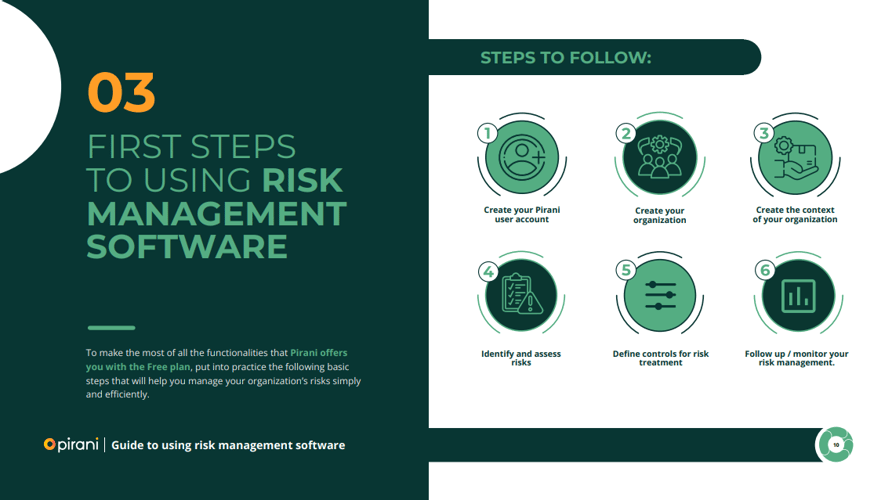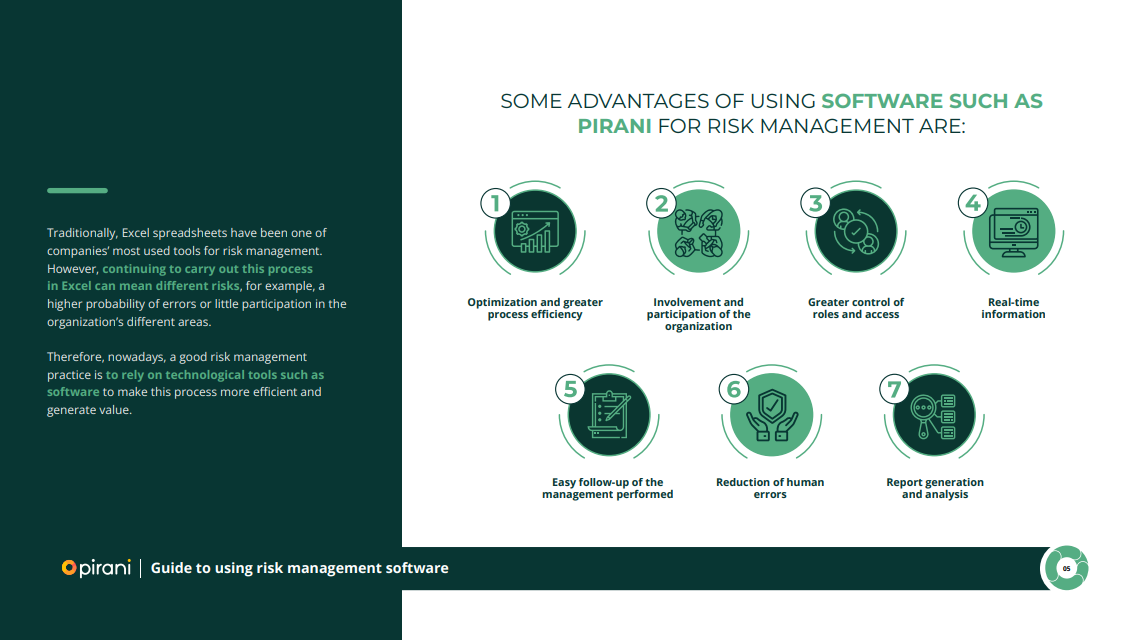Guide to using risk management software
|
Table of Contents |
Introduction
In a world of constant change, risk management must increasingly become a strategic process for all organizations, regardless of size and sector.
Risk management, in general, consists of identifying, assessing, controlling, and monitoring the different risks to which an organization is exposed, for example, financial risks, operational risks, regulatory compliance risks, information security risks, and cybersecurity, among many others.
But beyond these four key actions, the purpose of risk management is the creation and protection of the organization's value. It should serve to make informed decisions, improve performance, foster innovation, contribute to the achievement of strategic objectives, protect reputation, and contribute to the sustainability and continuity of the business.
Advantages of managing risks in software
Traditionally, Excel spreadsheets have been one of companies' most used tools for risk management. However, continuing to carry out this process in Excel can mean different risks, for example, a higher probability of errors or little participation in the organization's different areas.
Therefore, nowadays, a good risk management practice is to rely on technological tools such as software to make this process more efficient and generate value.
1. Optimization and increased process efficiency
The use of risk management software such as Pirani helps to optimize the different management actions, such as identifying processes and risks, risk assessment, and definition and qualification of controls. In addition, it allows all the information to be centralized, facilitating the permanent update of data and generating greater efficiency in the whole process.
2. Organizational Involvement and Participation
Thanks to the centralization of information in a single system and the creation of specific roles, it is easier to involve several people from different areas in the organization's risk management, contrary to what happens when using Excel, where access to information is usually very restricted.
Being able to involve more people in different activities of this process favors the risk culture in the organization. It helps to have a more effective management that responds to the company's specific reality.
3. Greater role and access control
In line with the previous advantage, managing risks in software allows for a higher level of protection and security of information because, on the one hand, users enter with a password. On the other hand, depending on the role assigned, they can only see the information to which they have access, that is, the processes, risk factors, risks, and controls directly related to their roles.
This helps avoid possible leaks or loss of relevant or critical information to the organization. In other words, software's role and access control also prevent unauthorized persons from accessing confidential information.
4. Real-time information
Another advantage of the risk management software compared to Excel is the ability to have the information in real-time. It will constantly be updated and available to whoever needs it according to the assigned roles and access granted.
5. Easy follow-up of the management performed
The use of software also helps to facilitate the follow-up or monitoring of the management performed, allowing to know, for example, the evolution of the risks identified and the controls implemented, that these are fulfilling the objective for which they were created and if not, to be able to make adjustments or create new ones promptly to ensure the prevention of risks or their adequate mitigation if they materialize.
6. Reduction of human error
Unlike Excel, where it is very likely that different mistakes are made, risk management software avoids making mistakes thanks to the controls and parameterizations defined, for example, the type of information that is allowed to be entered or if a field is mandatory, the user cannot move forward until it has been completed.
The data's quality, reliability, and integrity are essential in the software, which, as a whole, is valuable information that can be interpreted to generate knowledge and improve decision-making in the organization.
7. Report generation and analysis
Risk management software facilitates the generation of reports. In Pirani's Free plan, for example, users can have key reports for analysis and decision-making.
One of these is the heat map, which, among other things, serves to prioritize the treatment of risks according to their level (low, medium, high, critical) and makes it easy to know how risks are distributed, which ones are a priority to treat, how a risk evolves after applying controls (residual risk) and, in general, to make strategic decisions for the organization.
First steps to using risk management software:
To make the most of all the functionalities that Pirani offers you with the Free plan, put into practice the following steps that will help you efficiently manage your organization's risks.

Step 1. Create your Pirani user account
To manage risks in Pirani, you must first create your account. Doing it is very easy. You only have to enter data such as:
- E-mail (personal or corporate).
- First and last name.
- Contact telephone number
- Password must have more than eight characters, a capital letter, and a unique character.
Step 2. Create your organization
In this step, you must enter basic information about your organization. With this, we can provide you with a more specialized service that fits your company's context.
Some of the information you should fill in are:
- Name of the organization.
- Preferred language (English or Spanish).
- Management system for your Free plan, you can only choose one:
- ORM: operational risk management
- AML: money laundering risk management.
- ISMS: information security risk management
- Compliance: regulatory risk management
- Industry to which your organization belongs.
- How many people work in your organization?
- What is your current role?
- How do you plan to use Pirani?
Step 3. Create the contex of your organization
In this third step, several actions are important:
1. Creating roles and groups of responsible people.
Pirani allows you to create different roles in your organization. Depending on the roles you define, the users you invite to manage risks can create, edit, or delete information in the software (processes, risks, controls, etc.).
2. Invite members of your organization to support you in risk management.
Keep in mind that in the Free plan, you can have 5 users, so you can invite 4 people from your organization to help you manage the risks to which they are exposed.
Inviting users is very easy: you only have to enter the email address of the person or persons who will participate in the risk management of your organization and assign them a role (the software has 2 established roles: Administrator and Operator, the other roles are the ones you create), once you do it, the users will receive an email so that they can join and manage the risks.
3. Create the process structure and risk factors.
Processes and risk factors are the main inputs to manage risks. That is, they help you to give the initial context to perform the management, which consists of the stages of identification, evaluation, control, and monitoring of risks.
So, at this point, you need to create the whole process structure of your organization. If your chosen management system differs from ORM (operational risks), you must also create the corresponding risk sources:
- AML: factors such as customers, counterparties, channels, products, and jurisdictions.
- ISMS: information assets.
- Compliance: regulations.
Step 4. Identify and assess risk
After creating the specific processes and risk factors (if your system is other than ORM), in this step, you must identify the risks to which they are exposed. Different techniques exist to perform this identification, for example,
- Brainstorming.
- Interviews with the leaders or owners of the processes.
- Surveys.
- Analysis of the internal and external context.
- SWOT matrix (weaknesses, opportunities, strengths, and threats).
- Expert analysis.
- Reference lists in ChatGPT.
Step 5. Define controls for risk treatment
There are different ways to deal with risks: accept them, transfer them, mitigate them, or eliminate them. The latter implies eliminating the process or the risk factor that can generate it.
Here, you must establish the treatment strategy for each risk. In the case of mitigation, in Pirani, you can define and associate controls that allow you to reduce the probability of occurrence or mitigate the impact if the risk materializes.
Step 6. Follow up / monitor your risk management
For the proper risk management of your organization in Pirani's Free plan, in this last step, it is necessary to monitor the management system continuously.
This means that after having all the processes, risk sources, risks, and controls for their mitigation, you must follow up on them to know how the management is evolving and to be able to make timely decisions about them, for example, if new risks need to be added if it is necessary to modify the controls or create new ones because the existing ones are not being effective.
In general, this step is about keeping track of everything created in the software and making informed decisions based on this. Here, your organization must establish clear policies for monitoring the management system, for example, how often it will be done and the main people responsible for it.
Conclusion
With all this information that we have shared with you in this Basic Guide to using risk management software, it is time for you to start managing your organization's risks with Pirani's Free plan, with which you will be able to:
- Choose one of our risk management systems: ORM - AML - ISMS - Compliance. Have 5 users, 200 records and 2GB of storage indefinitely and free of charge.
- Have a risk management methodology already defined.
- Identify processes and risk factors (depending on the management system you choose).
- Identify and evaluate risks in terms of frequency and impact.
- Receive risk suggestions for your industry and processes thanks to the integration with ChatGPT.
- Define controls for risk mitigation.
- Control access to information by creating roles and groups of responsible parties.
- Attach evidence in the creation of processes, risk factors, risks, and controls and also export information for each of these.
- Perform continuous monitoring of the management performed.
- Analyze and download a basic heat map report.



